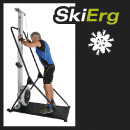
Check out the SkiErg
Wed, May 26, 2010 - By Judy Geer
It's that bittersweet time of year for skiers. On one hand, the ski season is always too short! On the other hand, we are starting to get a little tired. Tired of racing, tired of klister, tired of travel. Up here in northern VT we've had an exceptionally short season, with snow melting a good 2-3 weeks earlier than usual. Heck, they've been getting more snow down south than we have up here. What's going on? But still, the bare ground and muddy roads make us want to put on our running shoes instead of our skis. Dryland training season is upon us.
You'll probably want to take a break before diving into serious dryland training. Most skiers need some time off at the end of the season. So before you get back to serious training, make sure you are feeling rested, refreshed and ready to work again.
 An important aspect of training for serious skiers and coaches is to have a system of measuring progress. How else can you really know what you are gaining from your workouts, whether you are doing the right kinds of workouts to remedy your weaknesses, and in general whether your training plan is working. Common metrics include running or rollerskiing time trials, physiological testing, lactate testing, and strength testing. Some of these are more specific to skiing than others. With the introduction of the SkiErg, coaches and skiers can add a new, reliable and highly specific tool for tracking progress.
An important aspect of training for serious skiers and coaches is to have a system of measuring progress. How else can you really know what you are gaining from your workouts, whether you are doing the right kinds of workouts to remedy your weaknesses, and in general whether your training plan is working. Common metrics include running or rollerskiing time trials, physiological testing, lactate testing, and strength testing. Some of these are more specific to skiing than others. With the introduction of the SkiErg, coaches and skiers can add a new, reliable and highly specific tool for tracking progress.
The SkiErg is certainly not the only poling machine available to skiers, but it is the only one that offers an electronic Performance Monitor that is accurate, repeatable and informative. The PM technology has been developed through Concept2's years of making rowing ergs (The Concept2 Indoor Rower) and brings to skiers the same capabilities that rowers have been using for quite a few years now. In rowing, erg scores are used not just to monitor training progress, but also to identify athletes for everything from HS teams to National Team Selection Camps. But let's get back to skiing.
Here are some of the ways that the SkiErg might be used to help monitor the effectiveness of your dryland training program - not to mention its obvious uses as a training tool.

SkiErg display options
Periodic testing
You or your coach can choose the time or distance. The important thing is to perform the same test workout (s) at selected intervals over the course of your training period. You might start with a 5k early in the dryland season, then add a 2k and a 500m sprint when you start working on speed. Time the tests so that they come at strategic points in your training and can help you measure your progress from block to block.
Speed testing
By adjusting the damper on the SkiErg, you can simulate the range of different skiing tempos that you might encounter on the snow. If you perform the same test piece at a range of damper settings, you can plot a curve of your performance as a function of drag factor. You may find that you are really effective at slow hand speeds, but not so great at faster ones. Tweak your training accordingly, and re-test in a few weeks.
Compare with other skiers worldwide
As more and more skiers submit their PR's online, the Concept2 Online Ranking will become a powerful tool for seeing where you stand amongst fellow skiers around the world. There's already a pretty good quorum in there for the 1000m distance. Check it out at http://www.concept2.com/sranking03/rankings.asp. The Performance Monitor is constantly self-calibrating - so scores can be fairly compared whether performed at altitude or at sea-level, in any conditions.
We're sure that skiers and coaches will find other ways to take advantage of the training information provided by the SkiErg. Please don't hesitate to send us suggestions. We are excited to be working with the skiing community.
Check out the Ski Erg for your Team at www.SkiErg.com
